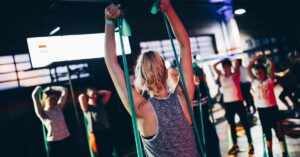Embracing Movement as a Lifestyle for Lasting Health Benefits

Embracing Movement as a Lifestyle for Lasting Health Benefits
Have you ever noticed how a simple stroll can turn a mundane day into something brighter? I remember the first time I stepped outside for a walk after being cooped up indoors for too long. It was as if a weight had lifted. The fresh air, the rustle of leaves, and the rhythm of my feet on the pavement felt like an awakening. This experience isn’t just a fleeting moment of joy; it’s a reminder of the profound impact movement can have on our health and well-being.
In a world increasingly dominated by screens and sedentary lifestyles, embracing movement as a way of life is more crucial than ever. It’s not merely about hitting the gym or logging hours at a fitness class. Instead, it’s about integrating movement into the fabric of our daily routines. This article explores the various health benefits of adopting an active lifestyle, practical ways to incorporate movement, and how to foster a sustainable approach to being active.
The Science of Movement
Let’s kick things off with a little science, shall we? Research consistently shows that regular physical activity is associated with a lower risk of chronic diseases, improved mental health, and enhanced longevity. According to the World Health Organization, adults should aim for at least 150 minutes of moderate-intensity exercise each week. But what does that really mean in terms of lifestyle choices? Well, it translates to more than just a workout; it’s a commitment to moving more and sitting less.
Studies suggest that moving our bodies—whether through structured exercise or everyday activities—can significantly reduce the risk of heart disease, stroke, type 2 diabetes, and even some forms of cancer. It’s almost like our bodies were designed to be in motion, and when we neglect that, we miss out on a multitude of health benefits. And let me tell you, the allure of curling up on the couch with a good book (or Netflix binge) is strong, but the rewards of movement are even stronger.
The Mental Health Connection
I’ll never forget a conversation I had with a friend who was feeling overwhelmed by life’s stresses. She decided to take up running, and it completely transformed her outlook. “It’s like my mind clears with every step,” she told me. This anecdote highlights a powerful truth: movement is not just beneficial for our physical health; it also plays a pivotal role in our mental well-being.
Engaging in regular physical activity can lead to improved mood, reduced anxiety, and even alleviation of depression symptoms. The endorphins released during exercise are often dubbed “feel-good hormones.” Who wouldn’t want a little more of that? And while exercise isn’t a cure-all, it certainly can be a valuable tool in managing stress and enhancing overall happiness.
Practical Ways to Incorporate Movement
Now, let’s get down to the nitty-gritty—how do we actually incorporate movement into our daily lives? It’s all about finding what works for you. Here are some practical tips that can help you embrace movement as a lifestyle:
- Take the Stairs: Whenever possible, opt for stairs instead of elevators. It’s a small change, but it adds up over time.
- Walk and Talk: Instead of sitting for meetings or phone calls, why not take them on the go? Walking meetings can spark creativity.
- Dance Like Nobody’s Watching: Seriously, put on your favorite playlist and dance around your living room. It’s a fantastic way to get your heart pumping and boost your mood.
- Set Reminders: Use technology to your advantage—set reminders on your phone to get up and move every hour.
- Find a Buddy: Whether it’s a friend, family member, or even a pet, having a movement partner can make it more enjoyable.
These suggestions may seem simple, yet they can create a significant shift in our daily routines. The goal isn’t to run a marathon (unless you want to, of course) but rather to find opportunities to move throughout the day.
Creating a Sustainable Movement Routine
As the saying goes, “Rome wasn’t built in a day.” Similarly, establishing a sustainable movement routine takes time and patience. It’s easy to get caught up in the enthusiasm of a new workout program—often to the point of burnout. Instead, focus on gradual changes that fit seamlessly into your lifestyle. This is where the magic happens.
After years of trial and error (and a few too many failed New Year’s resolutions), I finally discovered what worked for me. I started with short walks during my lunch break and gradually added in a few yoga sessions at home. Before I knew it, movement became a natural part of my day, rather than a chore. The key is to find activities you genuinely enjoy; otherwise, it’s easy to lose motivation. Nobody wants to feel like they’re dragging themselves to the gym, right?
Mindfulness in Movement
Movement doesn’t always have to be about sweating buckets or achieving a personal best. It can also be about being present in the moment. Mindful movement—such as yoga, tai chi, or even leisurely walks—can enhance your connection to your body and mind. I’ve found that taking a moment to breathe and focus on my movements can make even the simplest activities feel rejuvenating.
Consider the practice of yoga, which emphasizes breath and intentional movement. Many practitioners report feeling more centered and relaxed after a session. It’s not just about flexibility or strength; it’s about cultivating a deeper awareness of your body and how it moves through space.
Overcoming Barriers to Movement
Despite our best intentions, life has a funny way of getting in the way of our movement goals. Whether it’s a busy schedule, lack of access to facilities, or even physical limitations, barriers can crop up unexpectedly. It’s essential to acknowledge these challenges without letting them derail your efforts.
One common barrier is time—or rather, the perceived lack of it. Many people feel they simply don’t have the time to dedicate to exercise. But here’s a little secret: movement doesn’t have to be time-consuming. Even a 10-minute dance party in your living room can be a fantastic way to break up your day and get your heart rate up.
Another hurdle is the intimidation factor that can come with traditional gym environments. I remember walking into a gym for the first time, feeling like everyone was judging my every move. But movement can happen anywhere—at home, in a park, or even in your backyard. Embrace what makes you comfortable.
Finding Community and Support
As humans, we thrive on social connections. Finding a community that shares your movement goals can be incredibly motivating. Whether it’s a local running club, a dance class, or an online fitness group, surrounding yourself with like-minded individuals can make all the difference.
Moreover, consider the power of accountability. Sharing your goals with friends or family can help keep you on track. Perhaps you can even create a friendly competition—who can take the most steps in a week? These little nudges can be surprisingly effective in fostering a more active lifestyle.
The Long-Term Benefits of Movement
As we delve deeper into the concept of embracing movement, let’s not forget the long-term benefits. Regular activity doesn’t just improve our health in the present; it sets the stage for a healthier future. Maintaining an active lifestyle as we age can lead to better mobility, increased independence, and a higher quality of life.
Research indicates that older adults who engage in regular physical activity are less likely to experience falls, chronic pain, and cognitive decline. It’s almost as if movement acts as a protective shield for our bodies and minds. And who wouldn’t want that?
Moreover, the social aspects of movement can enhance our overall well-being. Engaging in group activities, whether it’s a dance class or a hiking group, can foster connections that contribute to a sense of belonging and community. It’s a win-win!
Conclusion: A Lifestyle Choice
In wrapping up this exploration of movement as a lifestyle, it’s essential to remember that embracing activity isn’t a one-size-fits-all approach. It’s about finding what resonates with you personally, whether that’s dancing in your kitchen, hiking with friends, or practicing yoga at dawn. The beauty lies in the journey of discovering how movement can enrich your life.
So, as you read this, I encourage you to reflect on your relationship with movement. What small changes can you make today? How can you infuse a bit more activity into your routine? The path to lasting health benefits begins with a single step—literally. Let’s lace up our shoes and embrace the joy of movement, one step at a time.
After all, life is a beautiful dance, and it’s time to join in.







